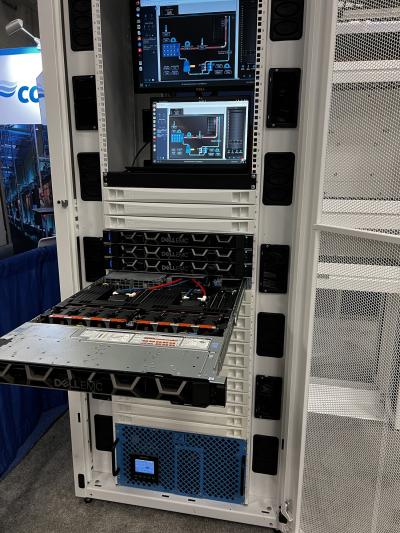-
Zutacore offers a two-phase direct liquid cooling system that uses non-conductive liquid
-
It believes water-based single-phase systems will hit a cooling cap even as chip power levels continue to rise
-
Dell'Oro's Lucas Beran said there's some truth to what Zutacore says but noted single-phase players are still innovating
It is a truth universally acknowledged that water and electronics don’t pair well together. And yet, most of today’s single phase direct liquid cooling (DLC) systems (including from the likes of Vertiv and CoolIT) use water-based glycol mixes. Zutacore wants to change that with a new two-phase direct-to-chip approach.
While water-based DLC systems can meet the cooling needs of high-power chips today, Udi Paret, Zutacore’s president for the U.S. market, told Silverlinings that the company believes its dielectric fluid-based HyperCool system is more scalable.
In case you don't know, dielectric fluids don’t conduct electricity like water does.
Water-based systems increase their cooling power by adjusting the speed of the water flow and the water input temperature, said Paret. However, at some point, water based systems “will run into a ceiling” because the heat generated by high-power chips will surpass the cooling capabilities of water alone.

“Right now, they’re kind of dancing around this. They might get to the 1,500 watts per chip, might stretch it to 2,000 [watts per chip] but what’s next? When those chips go into 3,000 or 4,000 [watts], what’s next?” he asked.
“Plus, the risk of leaks is becoming even more acute, both from the ability to control those but the impact because now with AI service we’re talking about each platform is a quarter of a million dollars.”
Paret explained that because Zutacore’s system (see image to the right) involves a state change from liquid to gas, it can remove more heat from servers – providing up to 70% heat capture with a tenth the amount of liquid used by single phase systems. He added the company has already tested its system to 1,500 watts and “see[s] no ceiling to that. We just didn’t test yet to higher” wattage.
“In a few months we’ll probably test to 2,000 [watts]. There’s no technical barrier there because we’re not dependent on flow,” Paret said.
Zutacore’s system has been certified to support Nvidia’s H100 and H200 GPUs. The company was on site at Nvidia’s recent GTC event showcasing its wares at in three different partner booths.
Paret said the company’s gear began rolling out in production data centers last year and Zutacore has already won projects at the 10 megawatt scale. It also has a growing pipeline of orders that is becoming significant, he said.
Cool reality check
Zutacore is not the only one making waves in the liquid cooling market. A number of other companies are also getting creative. For instance, Iceotope uses dielectric fluid in its single phase system. And, like Zutacore, Accelsius is peddling a water-free two-phase direct-to-chip solution called NeuCool to data center operators.
Dell’Oro Group Research Director Lucas Beran told Silverlinings said he generally takes what vendors say about their own technology with a grain of salt since most liquid cooling companies only support one technology. That means they generally don’t keep up with the latest and greatest happening with other forms of liquid cooling.
That said, he noted Paret has a point. Most single phase DLC players have publicly tested up to 1,000 or 1,200 watts per chip. Behind the scenes, Beran said, they’re not taking the two-phase threat lying down and are working to push the limits up to the 1,500-watt range to support future processors.
And coming back to the bit about leaks, Beran said these happen only a fraction of a percentage of the time. But they do happen – he’s seen the damage they can cause to server stacks firsthand. And even that tiny risk can be offputting to companies investing millions on high-performance computing gear.
That’s where vendors like Zutacore and others using dielectric fluids gain the upper hand.
On the off chance there was a leak in a dielectric system, the fluid “would just turn into a vapor when it got hot enough and you would have no damage,” Beran explained.
There’s an argument to be made that dielectric-based systems are more sustainable since if a water-based system leaks and damages server gear, more carbon has to be expended to replace that kit.
But “the biggest value proposition of two-phase direct liquid cooling…is that they are better aligned to support higher TDP processors at 1,500 watts and above,” Beran concluded. “As the roadmap continues to push toward higher TDP processors, something like a two-phase solution may become necessary to support that level of power consumption at the processor level.”
Silverlinings will be part of the new Fierce Network portal, starting April 8th. Get pumped!